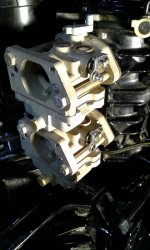I have a 1992 Merc 40 2 stroke 4 cylinder I have owned since new with WMA carbs that ran great 4 years ago; now, it won't idle. Has been in the garage for 4 years and not used. When I last winterized it, Stabil in gas tank, fogged it, drained the carb float bowls, filled the float bowls with Stabil, squirted fogging oil into the cylinders. This June, hauled the pontoon out into the driveway, added 10 gallons of fresh gas, added new plugs, dunked lower unit into a tub of water. Got it started but it really did not want to idle - figured it needed run on the water.
Launched it and found that it would run great at 1500rpms, 2000, 3000, 4000, and 5000 and ran like new; smooth up and down the throttle range; I normally run at 3500 rpms; however, it would die at idle in gear (800 rpms) or out of gear (1100 rpms) after about 10 seconds and sometimes would die immediately.
I have read the accounts of other posts about this problem and it seems the consensus is the carbs need cleaned.
I would like to verify that the problem is not electrical and not fuel pump and truely is the carbs before I get into the carbs and its idle circuit - whatever that is. I have the shop manual.
So, is it electrical or fuel pump or fuel filter or carbs?
What is the idle circuit?
Any help would be appreciated.
Launched it and found that it would run great at 1500rpms, 2000, 3000, 4000, and 5000 and ran like new; smooth up and down the throttle range; I normally run at 3500 rpms; however, it would die at idle in gear (800 rpms) or out of gear (1100 rpms) after about 10 seconds and sometimes would die immediately.
I have read the accounts of other posts about this problem and it seems the consensus is the carbs need cleaned.
I would like to verify that the problem is not electrical and not fuel pump and truely is the carbs before I get into the carbs and its idle circuit - whatever that is. I have the shop manual.
So, is it electrical or fuel pump or fuel filter or carbs?
What is the idle circuit?
Any help would be appreciated.



